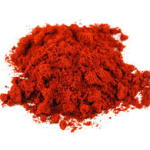The American Indians taught the Colonists how to tap the maple tree for its sap and boil it down to what the Indians called “Sweetwater.” Canada, New York and Vermont are all known for their superior maple products. Maple syrup is graded according to color and flavor. Generally, U.S. grades are: Fancy or Grade AA, a light amber colored syrup with a mild flavor; Grade A is medium amber and mellow flavored; Grade B is dark amber and hearty flavored; and Grade C is very dark with a robust, molasses like flavor. Since the processing of maple syrup is labor-intendisve, pure maple syrup is quite expensive. A less costly product is labeled maple-flavored syrup and is a combination of less expensive syrup, such as corn syrup, and a small amount of pure maple syrup. Pancake syrups are usually nothing more than corn syrup flavored with artificial maple extract. Go for broke and get the good stuff and refrigerate after opening.
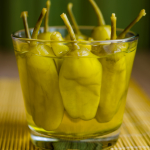 Pepperoncini – pronounced: pep-per-awn-CHEE-nee) Also called Tuscan peppers. These thin skinned bright yellow peppers are very mild and packed with little seeds. They have a slightly sweet and mild flavor and are really not that hot at all. You’ll find them usually pickled on an antipasti platter and are also served as a condiment to some sandwiches such as pastrami’s. Try them finely chopped in your next sour cream based dip.
Pepperoncini – pronounced: pep-per-awn-CHEE-nee) Also called Tuscan peppers. These thin skinned bright yellow peppers are very mild and packed with little seeds. They have a slightly sweet and mild flavor and are really not that hot at all. You’ll find them usually pickled on an antipasti platter and are also served as a condiment to some sandwiches such as pastrami’s. Try them finely chopped in your next sour cream based dip.
 Literally translated, the Greek word “Phyllo” means “leaf”. In the culinary world it refers to tissue-thin layers of pastry dough used in various Greek and Middle Eastern sweet and savory preparations. It’s best known to be used in the dessert “Baklava” and in “Spanokopita” – the mini spinach appetizers that are folded like a flag. You can find phyllo (or filo) in the frozen section in your grocery store. When frozen it can be stored up to 1 year and in the refrigerator for 1 month. Once opened, use within 2-3 days. Try to protect the delicate sheets of dough by placing a slightly damp paper towel over the unused phyllo as your assembling your dish – it tends to dry out very, very quickly and take it from me… it’s a BEAR (insert word here instead) to have phyllo become brittle when you’re trying to assemble a dish or appetizer (I have flag folded many a spanokopita in my days……)
Literally translated, the Greek word “Phyllo” means “leaf”. In the culinary world it refers to tissue-thin layers of pastry dough used in various Greek and Middle Eastern sweet and savory preparations. It’s best known to be used in the dessert “Baklava” and in “Spanokopita” – the mini spinach appetizers that are folded like a flag. You can find phyllo (or filo) in the frozen section in your grocery store. When frozen it can be stored up to 1 year and in the refrigerator for 1 month. Once opened, use within 2-3 days. Try to protect the delicate sheets of dough by placing a slightly damp paper towel over the unused phyllo as your assembling your dish – it tends to dry out very, very quickly and take it from me… it’s a BEAR (insert word here instead) to have phyllo become brittle when you’re trying to assemble a dish or appetizer (I have flag folded many a spanokopita in my days……)
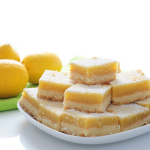 In tribute to a very special someone – today we honor the lemon bar! Well, at least I do by sharing my recipe….
In tribute to a very special someone – today we honor the lemon bar! Well, at least I do by sharing my recipe….
For a half sheet pan (13″x18’x1″), mix together 3/4 cup of sugar, 3 cups of flour and pinch of salt. Cut in 1-1/2 cups of cold butter and mix gently. Pat into the pan to form the crust. Chill for about 10-15 minutes in refrigerator, then bake at 350 for about 20 minutes until just slightly brown. While the crust is cooking, mix together 9 eggs, 4-1/2 cups sugar, 2 cups fresh lemon juice and 1-1/2 cups of flour. Whisk together well. When crust is done, cool about 3-5 minutes then add the lemon-egg mixture then bake for about 35 minutes at 350 degrees. Cool completely, maybe even overnight in refrigerator. Cut into squares and enjoy – “This one’s for you!”
This is one of my fav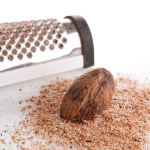 orite spices to use fresh. Supposedly Columbus was actually looking for this spice in the east indies when he sailed from Spain. This seed comes from the nutmeg tree and was extremely popular in the 15th to the 19th century. the hard, egg-shaped nutmeg seed is grayish brown and about 1 inch long. The flavor and aroma are delicately warm, spicy and sweet. It is sold ground and whole but I say purchase it whole and use a grinder as pictured or a micro-plane zester for freshly ground – it makes a big difference. It is excellent when used in baked goods, milk or cream based sauces and custards. It’s also complimentary to many vegetables like spinach, squash and potatoes! Once you use it whole, you’ll never buy the jar of ground nutmeg again.
orite spices to use fresh. Supposedly Columbus was actually looking for this spice in the east indies when he sailed from Spain. This seed comes from the nutmeg tree and was extremely popular in the 15th to the 19th century. the hard, egg-shaped nutmeg seed is grayish brown and about 1 inch long. The flavor and aroma are delicately warm, spicy and sweet. It is sold ground and whole but I say purchase it whole and use a grinder as pictured or a micro-plane zester for freshly ground – it makes a big difference. It is excellent when used in baked goods, milk or cream based sauces and custards. It’s also complimentary to many vegetables like spinach, squash and potatoes! Once you use it whole, you’ll never buy the jar of ground nutmeg again.
Pomodoro! Literally translating to “golden apple”, pomodoro is Italian for “tomato” the first tomatoes in Italy were actually a yellowish color. Next time you’re at an Italian restaurant and you see “Al Pomodoro” on the menu – no, it’s not that guy you went to high school with – it means that the dish is served with tomato sauce!!!
Roquefort is at least one of the oldest and best known in the world. This fabulous blue cheese has been enjoyed since Roman times – even Caesar was a fan! It is made from sheep’s milk that is exposed to a mold known as Penicillium roqueforti and aged for about 3 months or more in the limestone caverns of Mount Comaulou near the village of Roquefort in southwestern France. Roquefort has a creamy-rich texture and pungent, piquant, somewhat salty flavor. It has a creamy white interior with blue veins and an ivory rind. It’s sold in foil wrapped cylinders. This is a great cheese to serve at the end of the meal with a fine port or dessert wine. The MINIMUM fat content for Roquefort is 52%…. explains a lot now…..
It’s that time of year to break out the grill and slap a nice rib-eye steak down! This tender, flavorful beef steak is a boneless cut from the rib section – between the short loin and the chuck. If the bones are removed the result is the extremely tender rib-eye steak. If bones left in, then known as a rib-steak. Both should be quickly cooked by grilling, broiling or frying.
 Grown primarily around the Mediterranean and now California (yay!), this sweet-tart orange has a bright red flesh. Most blood oranges are best eaten fresh, but the more acidic varieties like the Maltese work well in cooked sauces like the Hollandaise based Maltaise sauce.
Grown primarily around the Mediterranean and now California (yay!), this sweet-tart orange has a bright red flesh. Most blood oranges are best eaten fresh, but the more acidic varieties like the Maltese work well in cooked sauces like the Hollandaise based Maltaise sauce.
The flesh develops its characteristic maroon color when the fruit develops with low temperatures during the night. Sometimes there is dark coloring on the exterior of the rind as well, depending on the variety of blood orange. The skin can be tougher and harder to peel than that of other oranges. The blood orange is a natural mutation of the orange.
Blood oranges may have originated in either China or the Southern Mediterranean, where they have been grown since the 18th century. They are now the primary orange grown in Italy. Italy. The anthocyanins which give the orange its distinct maroon color will only develop when temperatures are low at night, as during the Mediterranean fall and winter. Blood oranges cultivated in the United States are in season from December to March (Texas), and from November to May (California). Since they are only around in the spring season and make such a lovely addition to your mimosa instead of regular orange juice – a bright vibrant color. If you can, juice these oranges and freeze the juice for use all year round.
Blood oranges have a unique flavor profile compared to other oranges, being distinctly raspberry-like in addition to the usual citrus notes.
Some blood orange juice may be somewhat tart, while other kinds are sweet while retaining the characteristic blood orange taste. The oranges can also be used to create marmalade, and the zest can be used for baking. A popular Sicilian winter salad is made with sliced blood oranges, sliced bulb fennel, and olive oil. The oranges have also been used to create gelato, sorbet and Italian Soda. Blood oranges are also popular in vinaigrette-style dressings, and are sometimes used to flavor niche-market beer.
Blood oranges are a source of vitamin C like all citrus fruits. A medium-sized orange also provides 28% of the recommended daily intake of dietary fiber.
Vineg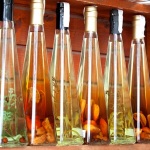 ar is derived from the French vin aigre, “sour wine” – vinegar is made by bacterial activity that converts fermented liquids such as wine, beer or cider into a weak solution of acetic acide, which makes it sour. There are a myriad of vinegars on the market days. You have the fruity apple cider vinegar, made from fermented apple cider; the harsh-tasting distilled white vinegar and the please pungent vinegars made from either red or white wine. Then there’s malt vinegar, obtained from malted barley, the mild slightly sweet rice vinegar, made from fermented rice; and a dazzling array of fruit and herb flavored vinegars that you can find at more upscale markets or gourmet stores. Keep your vinegars in a cool dry place, avoiding keeping them around your hot stove/oven as that will diminish their flavor – they’ll look good but really not assist you in your cooking. Unopened vinegar will keep indefinitely while open vinegar will keep up to 6 months. Experiment when you can with vinegar for dressings and sauces, tasting while you go – remember ¼ vinegar to ¾ oil when you’re making a salad dressing.
ar is derived from the French vin aigre, “sour wine” – vinegar is made by bacterial activity that converts fermented liquids such as wine, beer or cider into a weak solution of acetic acide, which makes it sour. There are a myriad of vinegars on the market days. You have the fruity apple cider vinegar, made from fermented apple cider; the harsh-tasting distilled white vinegar and the please pungent vinegars made from either red or white wine. Then there’s malt vinegar, obtained from malted barley, the mild slightly sweet rice vinegar, made from fermented rice; and a dazzling array of fruit and herb flavored vinegars that you can find at more upscale markets or gourmet stores. Keep your vinegars in a cool dry place, avoiding keeping them around your hot stove/oven as that will diminish their flavor – they’ll look good but really not assist you in your cooking. Unopened vinegar will keep indefinitely while open vinegar will keep up to 6 months. Experiment when you can with vinegar for dressings and sauces, tasting while you go – remember ¼ vinegar to ¾ oil when you’re making a salad dressing.
There are di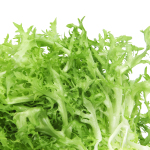 fferent varieties of Endive – this one is the Escarole which is a member of the chicory family. It has a broad, slightly curved, pale green leaves with a milder flavor than either Belgian or curly endive. Both curly endive and escarole are available year-round, with the peak season from June through October. They should be selected for their fresh, crisp texture, avoid heads with discoloration or insect damage. Store the escarole, tightly wrapped in the refrigerator for up to 3 days. It can be used in salad but can salads, but briefly cooked and eaten as a vegetable or in soups.
fferent varieties of Endive – this one is the Escarole which is a member of the chicory family. It has a broad, slightly curved, pale green leaves with a milder flavor than either Belgian or curly endive. Both curly endive and escarole are available year-round, with the peak season from June through October. They should be selected for their fresh, crisp texture, avoid heads with discoloration or insect damage. Store the escarole, tightly wrapped in the refrigerator for up to 3 days. It can be used in salad but can salads, but briefly cooked and eaten as a vegetable or in soups.
Black  rice (also known as purple rice) is an heirloom variety of glutinous rice cultivated in Asia. It is typically sold as an unmilled rice, meaning the fiber-rich black husks of the rice are not removed. The unusual color makes it very popular for desserts, and the high nutritional value is an added benefit. This rice is often served with fresh fruit such as mangoes and lychees, especially when drizzled with a fruit or rice syrup.Soaking and cooking reveals the true color of this rice, which is actually a rich purple to burgundy, though the grains do appear to be black when they are uncooked. The natural color of the rice will dye foods added to it, such as coconut milk. It can also be eaten with entree courses, although this is less common. This grain is often used to make Chinese desserts, though it is also popular in many other Asian nations, all of which have their own special names for the product. It is also claimed to be good for the kidney, stomach and liver.
rice (also known as purple rice) is an heirloom variety of glutinous rice cultivated in Asia. It is typically sold as an unmilled rice, meaning the fiber-rich black husks of the rice are not removed. The unusual color makes it very popular for desserts, and the high nutritional value is an added benefit. This rice is often served with fresh fruit such as mangoes and lychees, especially when drizzled with a fruit or rice syrup.Soaking and cooking reveals the true color of this rice, which is actually a rich purple to burgundy, though the grains do appear to be black when they are uncooked. The natural color of the rice will dye foods added to it, such as coconut milk. It can also be eaten with entree courses, although this is less common. This grain is often used to make Chinese desserts, though it is also popular in many other Asian nations, all of which have their own special names for the product. It is also claimed to be good for the kidney, stomach and liver.
It also has a very rich, slightly sweet, strongly nutty flavor. The rice is naturally high in iron, which causes the dense purple color, and it is also high in fiber, since the bran is left on the rice. It is also rich in a variety of other valuable vitamins and minerals. You can find the black rice at Trader Joe’s and other variety of grocery stores. It’s very simple to cook and will add a nice variety to your dishes.
This kid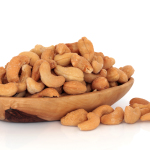 ney shaped nut grows out from the bottom of the cashew apple. Cashew nuts have a sweet, buttery flavor and contain about 48 percent fat. Because of their high fat content, they should be stored, tightly wrapped, in the freezer to keep from going rancid. If you roast them, their nutty flavor will increase.
ney shaped nut grows out from the bottom of the cashew apple. Cashew nuts have a sweet, buttery flavor and contain about 48 percent fat. Because of their high fat content, they should be stored, tightly wrapped, in the freezer to keep from going rancid. If you roast them, their nutty flavor will increase.
The cashew nut is served as a snack or used in recipes, like other nuts, although it is actually a seed, even though we will call it a nut. The cashew apple is a fruit, whose pulp can be processed into a sweet, astringent fruit drink or distilled into liqueur.
Did you know the shell of the cashew nut is toxic, which is why the nut is never sold in the shell to consumers?
Cashew nuts are commonly used in Indian cuisine, whole for garnishing sweets or curries, or ground into a paste that forms a base of sauces for curries or some sweets. It is also used in powdered form in the preparation of several Indian sweets and desserts. In Goan cuisine, both roasted and raw kernels are used whole for making curries and sweets.
This 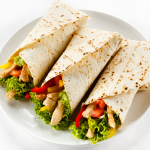 Mexican-style “Sandwich” consists of a folding corn or flour tortilla filled with various ingredients such as beef, pork, chicken, chorizo sausage, seafood, tomatoes, lettuce, cheese, etc. Here’s a version of a healthy taco filled with vegetables and chicken. Tacos can be had as an entrée or snack. They can be fried for a hard shelled taco, but you’ll be getting all the calories. Soft shell may be the way to go, try with a wheat tortilla for an even healthier snack or dinner. Great side dish for that margarita or cerveza for Cince De Mayo manana!
Mexican-style “Sandwich” consists of a folding corn or flour tortilla filled with various ingredients such as beef, pork, chicken, chorizo sausage, seafood, tomatoes, lettuce, cheese, etc. Here’s a version of a healthy taco filled with vegetables and chicken. Tacos can be had as an entrée or snack. They can be fried for a hard shelled taco, but you’ll be getting all the calories. Soft shell may be the way to go, try with a wheat tortilla for an even healthier snack or dinner. Great side dish for that margarita or cerveza for Cince De Mayo manana!
Eggs B enedict is a breakfast or brunch specialty consisting of two toasted English muffin halves, each topped with a slice of ham or Canadian bacon, a poached egg and a dollop of hollandaise. The most popular legend of the dish’s origin says that it originated at Manhattan’s famous Delmonico’s Restaurant when regular patrons, Mr. and Mrs. LeGrand Benedict, complained that there was nothing new on the lunch menu. The maître d’ and Mrs. Benedict began discussing the possibilities and Eggs Benedict was the result. This could be suspect as there are a few rumors on how the dish was originated but let’s be glad it’s on most of the breakfast/brunch menus around town!
enedict is a breakfast or brunch specialty consisting of two toasted English muffin halves, each topped with a slice of ham or Canadian bacon, a poached egg and a dollop of hollandaise. The most popular legend of the dish’s origin says that it originated at Manhattan’s famous Delmonico’s Restaurant when regular patrons, Mr. and Mrs. LeGrand Benedict, complained that there was nothing new on the lunch menu. The maître d’ and Mrs. Benedict began discussing the possibilities and Eggs Benedict was the result. This could be suspect as there are a few rumors on how the dish was originated but let’s be glad it’s on most of the breakfast/brunch menus around town!
Aran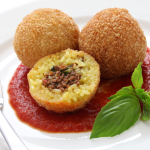 cine (Air-Ran-CHEE-Knee) A Sicilian specialty of saffron flavored rice balls stuffed with varying ingredients that can include meat, meat sauce, vegetables and/or cheese. The rice balls are coated with breadcrumbs and usually fried, though they can also be baked. The word arancine means “little oranges” and refers to both the shape of the fruit and the orange color from the saffron. Arancine are a popular street food and often used as appetizers. If you see this on your favorite Italian restaurant menu, try it!
cine (Air-Ran-CHEE-Knee) A Sicilian specialty of saffron flavored rice balls stuffed with varying ingredients that can include meat, meat sauce, vegetables and/or cheese. The rice balls are coated with breadcrumbs and usually fried, though they can also be baked. The word arancine means “little oranges” and refers to both the shape of the fruit and the orange color from the saffron. Arancine are a popular street food and often used as appetizers. If you see this on your favorite Italian restaurant menu, try it!
A member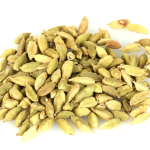 of the ginger family, this aromatic spice is native to India and grows in many other tropical areas including Asia, South America and the Pacific Islands. Cardamom seeds are encapsulated in small pods about the size of a cranberry. Each pod containers 17 to 20 tiny seeds. Cardamom has a pungent aroma and a warm, spicy-sweet flavor. You can purchase cardamom by either pod (pictured) or ground, the latter more convenience is not as full flavored because cardamom seeds begin to lose their essential oils as soon as they are ground. You can attempt to ground yourself using a mortar and pestle or spice grinder. If using this method in a soup or stew, the shell will disintegrate in the broth while the dish cooks. If using in a baked good, purchase the already ground cardamom. Be frugal when using cardamom – a little goes a long way.
of the ginger family, this aromatic spice is native to India and grows in many other tropical areas including Asia, South America and the Pacific Islands. Cardamom seeds are encapsulated in small pods about the size of a cranberry. Each pod containers 17 to 20 tiny seeds. Cardamom has a pungent aroma and a warm, spicy-sweet flavor. You can purchase cardamom by either pod (pictured) or ground, the latter more convenience is not as full flavored because cardamom seeds begin to lose their essential oils as soon as they are ground. You can attempt to ground yourself using a mortar and pestle or spice grinder. If using this method in a soup or stew, the shell will disintegrate in the broth while the dish cooks. If using in a baked good, purchase the already ground cardamom. Be frugal when using cardamom – a little goes a long way.
Dolma is singul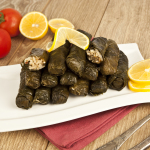 ar, dolmades plural. From the Arabic word for “something stuffed,” referring to grape leaves, vegetables or fruits stuffed with a savory, well-seasoned filling. Among the most popular dolmades are grape leaved stuffed with a filling of ground lamb, rice, onion, currants, pinenuts and various seasonings. Other foods used as casings include squash, eggplant, sweet peppers, cabbage leaves, quinces and apples. Dolmades are usually braised or baked in liquid and/or olive oil and topped with a bit of lemon juice right before serving. The dolmades containing meat are usually served warm while the ones with rice and vegetables are good cold or room temperature. They are very time consuming to make but well worth it. You can find the grape leaves as international markets in the Middle Eastern section.
ar, dolmades plural. From the Arabic word for “something stuffed,” referring to grape leaves, vegetables or fruits stuffed with a savory, well-seasoned filling. Among the most popular dolmades are grape leaved stuffed with a filling of ground lamb, rice, onion, currants, pinenuts and various seasonings. Other foods used as casings include squash, eggplant, sweet peppers, cabbage leaves, quinces and apples. Dolmades are usually braised or baked in liquid and/or olive oil and topped with a bit of lemon juice right before serving. The dolmades containing meat are usually served warm while the ones with rice and vegetables are good cold or room temperature. They are very time consuming to make but well worth it. You can find the grape leaves as international markets in the Middle Eastern section.
Native to China , this odd-looking kiwi received its moniker from New Zealand’s national (and flightless) bird of the same name. It looks like a large brown fuzzy egg. The covering actually hides a beautiful, brilliant green flesh, spattered with tiny edible black seeds. Kiwi flavor is elusive – some say the flavor of pineapple, others say strawberry but all agree that it has a sweet tart flavor unlike any other fruit. The kiwi is cultivated in both New Zealand and California. This fruit is available pretty much all year-round. Ripe kiwis will give slightly to gentle pressure and can be stored in the refrigerator up to 3 weeks. Two kiwis contain more potassium than a banana, as much fiber as a grapefruit and twice as much vitamin C as an orange. You can ripen them faster by placing the kiwi in a brown bag with an apple or banana. Seal and let stand at room temperature overnight. The ethylene gas emitted by the apple or banana help other fruit ripen more quickly … .but that’s another tip for another time.
, this odd-looking kiwi received its moniker from New Zealand’s national (and flightless) bird of the same name. It looks like a large brown fuzzy egg. The covering actually hides a beautiful, brilliant green flesh, spattered with tiny edible black seeds. Kiwi flavor is elusive – some say the flavor of pineapple, others say strawberry but all agree that it has a sweet tart flavor unlike any other fruit. The kiwi is cultivated in both New Zealand and California. This fruit is available pretty much all year-round. Ripe kiwis will give slightly to gentle pressure and can be stored in the refrigerator up to 3 weeks. Two kiwis contain more potassium than a banana, as much fiber as a grapefruit and twice as much vitamin C as an orange. You can ripen them faster by placing the kiwi in a brown bag with an apple or banana. Seal and let stand at room temperature overnight. The ethylene gas emitted by the apple or banana help other fruit ripen more quickly … .but that’s another tip for another time.
This beautiful Italian dessert consisting of tubular or horn-shaped pastry shells that have been deep fried, then filled with a sweetened filling of whipped ricotta cheese and sometimes whipped crème or mascarpone cheese which may have been flavored with vanilla or orange flower water and maybe a hint of cinnamon. Chopped pistachios, semi-sweet chocolate pieces and candied citrus peel or cherries are still oven included, dotting the open ends of the pastries. I can still taste the one I had in Taormina, Italy back in summer of 2000 – it was magical!!!
Italian dessert consisting of tubular or horn-shaped pastry shells that have been deep fried, then filled with a sweetened filling of whipped ricotta cheese and sometimes whipped crème or mascarpone cheese which may have been flavored with vanilla or orange flower water and maybe a hint of cinnamon. Chopped pistachios, semi-sweet chocolate pieces and candied citrus peel or cherries are still oven included, dotting the open ends of the pastries. I can still taste the one I had in Taormina, Italy back in summer of 2000 – it was magical!!!
This bright gorg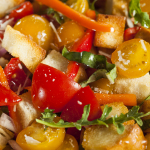 eous dish is an Italian bread salad made with onions, tomatoes, basil, olive oil, vinegar and seasoning and chunks of bread. Some versions may include cucumbers, anchovies and /or peppers. Try it with toasted bread chunks with a little garlic or by sautéing bread chunks in a little olive oil to add that crunch to the salad. The 16th Century artist and poet Bronzino sings the praises of onions with oil and vinegar served with toast then sings the praises of a salad with onions and cucumbers. This is often interpreted as the description of panzanella. Pan meaning bread in many languages. Great way to use up those leftover tomatoes and baguette of bread. A glass of red wine and dinner is complete!
eous dish is an Italian bread salad made with onions, tomatoes, basil, olive oil, vinegar and seasoning and chunks of bread. Some versions may include cucumbers, anchovies and /or peppers. Try it with toasted bread chunks with a little garlic or by sautéing bread chunks in a little olive oil to add that crunch to the salad. The 16th Century artist and poet Bronzino sings the praises of onions with oil and vinegar served with toast then sings the praises of a salad with onions and cucumbers. This is often interpreted as the description of panzanella. Pan meaning bread in many languages. Great way to use up those leftover tomatoes and baguette of bread. A glass of red wine and dinner is complete!
Sweeten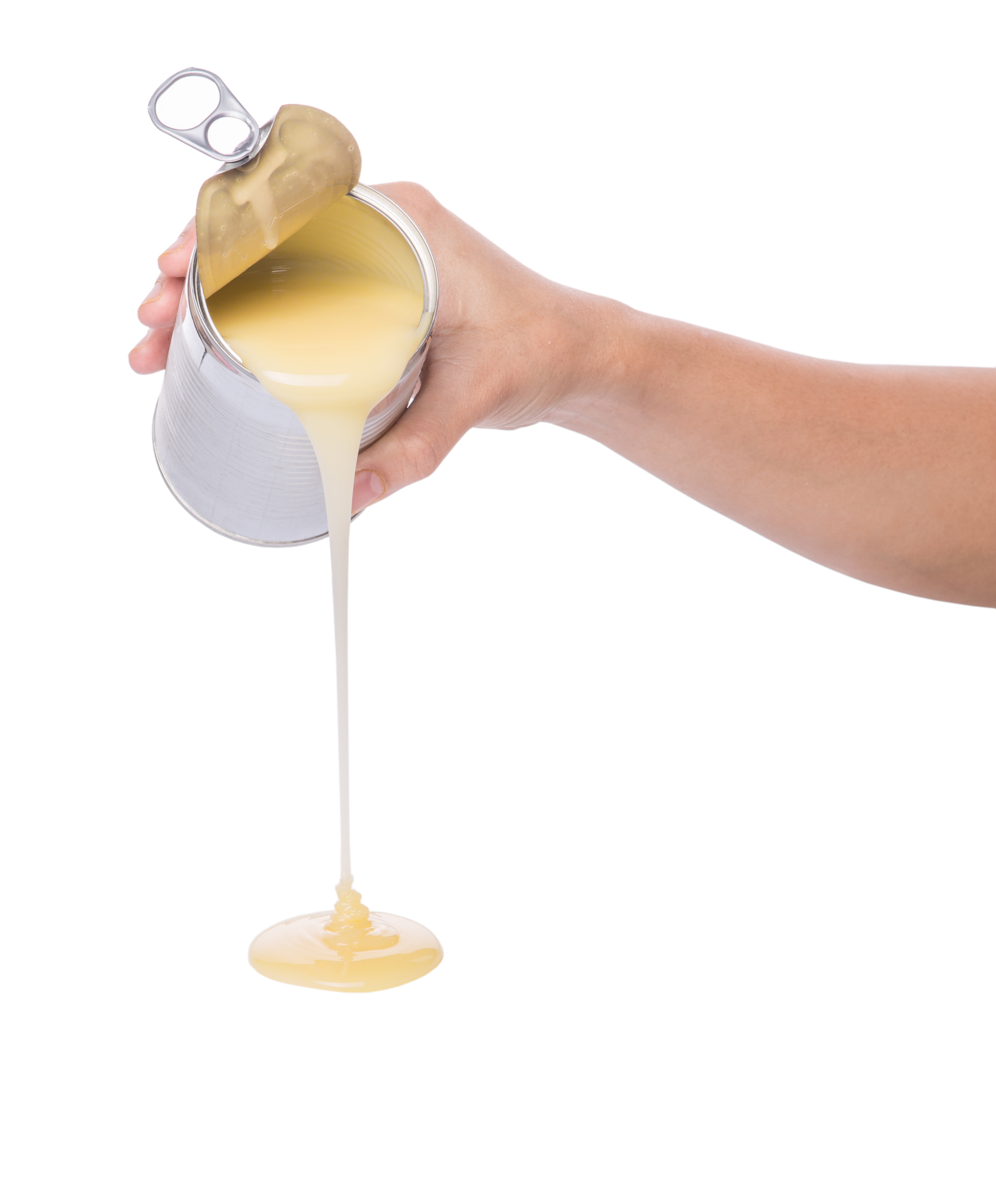 ed Condensed Milk: A mixture of whole milk and sugar, 40-45% of which is sugar. This mixture is heated until about 60 percent of the water evaporates. The resulting condensed mixture is extremely sticky and sweet. Store unopened sweetened condensed milk in the can at room temperature for up to 6 months. Once opened, transfer the unused milk to an airtight container, refrigerate and use within 5 days. Sweetened condensed milk is used to make candies, puddings and pies and also used in the Chefelle flan. Don’t confuse sweetened condensed milk with evaporated milk. Evap milk is UNsweetened milk that has been reduced by half. The two are not interchangeable. Evaporated is available in whole, low fat and fat free varieties.
ed Condensed Milk: A mixture of whole milk and sugar, 40-45% of which is sugar. This mixture is heated until about 60 percent of the water evaporates. The resulting condensed mixture is extremely sticky and sweet. Store unopened sweetened condensed milk in the can at room temperature for up to 6 months. Once opened, transfer the unused milk to an airtight container, refrigerate and use within 5 days. Sweetened condensed milk is used to make candies, puddings and pies and also used in the Chefelle flan. Don’t confuse sweetened condensed milk with evaporated milk. Evap milk is UNsweetened milk that has been reduced by half. The two are not interchangeable. Evaporated is available in whole, low fat and fat free varieties.
Also called 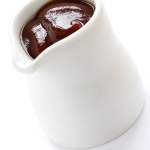 Peking sauce, this thick, reddish brown sauce is sweet and spicy, and widely used in Chinese cooking. It’s a mixture of soybeans, garlic, chili and various spices. Hoisin is mainly used as a table condiment and as a flavoring agent for many meat, poultry and shellfish dishes. It can be found in the Asian section of your supermarket and in many larger grocery stores. Once opened, canned hoisin should be transferred to a non-metal container, tightly sealed and refrigerated. Bottled hoisin can be refrigerated as is. Both will keep indefinitely when stored in this manner. Add a little hoisin to some sesame oil, soy sauce and you’ll have a lovely dipping sauce for dumplings and eggrolls. Add hoisin sauce to BBQ sauce and give your next rack of ribs an Asian inspiration!
Peking sauce, this thick, reddish brown sauce is sweet and spicy, and widely used in Chinese cooking. It’s a mixture of soybeans, garlic, chili and various spices. Hoisin is mainly used as a table condiment and as a flavoring agent for many meat, poultry and shellfish dishes. It can be found in the Asian section of your supermarket and in many larger grocery stores. Once opened, canned hoisin should be transferred to a non-metal container, tightly sealed and refrigerated. Bottled hoisin can be refrigerated as is. Both will keep indefinitely when stored in this manner. Add a little hoisin to some sesame oil, soy sauce and you’ll have a lovely dipping sauce for dumplings and eggrolls. Add hoisin sauce to BBQ sauce and give your next rack of ribs an Asian inspiration!
Cooked bread and cheese is an ancient food, according to food historians, popular across the world in many cultures; evidence indicates that in the U.S., the modern version of the grilled cheese sandwich originated in the 1920s when inexpensive sliced bread and American cheese became easily available. The so-called cheese dream became popular in the United States of America during the Great Depression.
It was originally made as an open sandwich, but the top slice of bread became common by the 1960s.U.S. government cookbooks describe Navy cooks broiling “American cheese filling sandwiches” during World War II. Many versions of the grilled cheese sandwich can now be found on restaurant menus across the United States and internationally.
A grilled cheese sandwich is assembled and then heated until the bread crisps and the cheese melts, sometimes combined with an additional ingredient such as bacon, tomatoes or onions. Several different methods of heating the sandwich are used, depending on the region and personal preference. Common methods include being cooked on a griddle, grilled, fried in a pan or made in a panini grill or sandwich toaster (this method is more common in the United Kingdom where the sandwiches are normally called “toasted sandwiches” or “toasties” and in Australia where they are called “jaffles”). A clothes iron has also been utilized to make a grilled cheese in a pinch, as in a hotel room where there are no other cooking appliances.
When making grilled cheese on an open griddle or pan, one side is cooked first, then the sandwich is flipped and cooked on the other side. The sandwich is finished when both sides are toasted and the cheese has melted. Butter, oil, or mayonnaise may first be spread on either the bread or the cooking surface in the case of butter and oil. An alternative technique is to toast or grill each half of the sandwich separately, then combine them. Another method sometimes referred as an “inside out” grilled cheese has an extra layer of cheese put on the outside of each side and cooked, causing the cheese to caramelize into a crispy outer layer.
When using butter best results are achieved at a medium heat. This prevents the milk solids in butter from burning and allows sufficient time for heat to thoroughly penetrate the sandwich and melt the cheese without burning the bread. A crispy golden-brown crust with a melted cheese center is a commonly preferred level of preparedness. Cooking times can vary depending on pan dimensions, ability to control the intensity of the heat source, bread type, cheese variety and overall thickness of pre-cooked sandwich.
Source: Wikipedia
This lovely che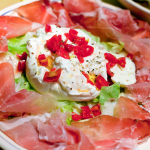 ese is an Italian creation made by the pasta filata process, whereby the fresh curd is dipped into hot whey, then stretched and kneaded to the desired pliability. To create Burrata, the cheesemaker uses the stretched curd to form a bag about 1/3” thick, which is filled with bits of unspun mozzarella and cream. The top is twisted closed and the pouch is dipped in brine. The cream thickens inside the bag, which produces a soft, rich center with a fresh milk quality that oozes out when the cheese is cut. This fresh cheese can be found in specialty cheese shops, Trader Joes, and gourmet type grocery stores. It must be refrigerated immediately and consumed within a few days. Most come from Italy though it is now produced in the United States, more locally there is a cheesemaker in El Monte that specializes in making Burrata. If you ever see this on the menu – take a chance and order it, you won’t be sorry!
ese is an Italian creation made by the pasta filata process, whereby the fresh curd is dipped into hot whey, then stretched and kneaded to the desired pliability. To create Burrata, the cheesemaker uses the stretched curd to form a bag about 1/3” thick, which is filled with bits of unspun mozzarella and cream. The top is twisted closed and the pouch is dipped in brine. The cream thickens inside the bag, which produces a soft, rich center with a fresh milk quality that oozes out when the cheese is cut. This fresh cheese can be found in specialty cheese shops, Trader Joes, and gourmet type grocery stores. It must be refrigerated immediately and consumed within a few days. Most come from Italy though it is now produced in the United States, more locally there is a cheesemaker in El Monte that specializes in making Burrata. If you ever see this on the menu – take a chance and order it, you won’t be sorry!
When Reyn olds Wrap® Aluminum Foil was introduced in 1947, it was advertised as “the pure aluminum foil for 1,001 kitchen miracles.” What made aluminum foil so useful back then is still true today.
olds Wrap® Aluminum Foil was introduced in 1947, it was advertised as “the pure aluminum foil for 1,001 kitchen miracles.” What made aluminum foil so useful back then is still true today.
Foil is just as useful today as it was back then, and it offers a variety of different foil products to meet your various household needs. Foil is moisture-proof, odor-proof, grease-proof, and it can be molded to any shape. Aluminum foil is available in a variety of widths and thicknesses to accommodate just about any task. It withstands high heat and extreme cold, making it perfect for everything from grilling to freezer storage. Foil minimizes cleanup and ensures that your food stays moist and tastes delicious.
| Why does aluminum foil not get hot when it is in a hot oven?
Actually, it does get hot. In fact, if you wrap a potato in aluminum foil and put it in a hot over, the foil will get hot first. This is because metals like aluminum are very good conductors of heat, so they absorb heat very quickly. When you pull out the potato, the same property of being a good heat conductor makes sure that the foil cools down very fast. It does get hot, but since it is so thin, and an excellent thermal conductor (being metal), it radiates/conducts away all of its heat so rapidly that it cools off much faster than anything else. |
The almon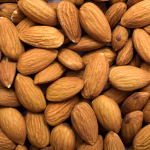 d is really not a nut at all but the kernel of the almond tree fruit which are grown extensively in California, the Mediterranean, Australia and South America. There are 2 main types of almonds, sweet and bitter. The flavor of sweet almonds is delicate and slightly sweet and are readily available in markets and are the variety used in recipes. They carry a healthy dose of oleic acid, an antioxidant. In a nutshell, almonds are a nutritional powerhouse packed with calcium, fiber, folic acid, magnesium, potassium, riboflavin and vitamin E. For the sweet almonds, toasting them before using in recipes intensifies their flavor and adds crunch. The sale of bitter almonds is illegal in the United states due to the toxicity that is destroyed wtihin the nuts are heated. When they are processed they are used to flavor extracts and liqueurs.
d is really not a nut at all but the kernel of the almond tree fruit which are grown extensively in California, the Mediterranean, Australia and South America. There are 2 main types of almonds, sweet and bitter. The flavor of sweet almonds is delicate and slightly sweet and are readily available in markets and are the variety used in recipes. They carry a healthy dose of oleic acid, an antioxidant. In a nutshell, almonds are a nutritional powerhouse packed with calcium, fiber, folic acid, magnesium, potassium, riboflavin and vitamin E. For the sweet almonds, toasting them before using in recipes intensifies their flavor and adds crunch. The sale of bitter almonds is illegal in the United states due to the toxicity that is destroyed wtihin the nuts are heated. When they are processed they are used to flavor extracts and liqueurs.
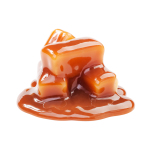 The term “caramel” has two meanings: the highest stage of heated sugar (also caramelized/caramelization) and a confection (candy). According to the food historians, caramelization was practiced in France in the 17th century. Pralines are an example of a caramelized confection. Caramel candies, as we think of them today, surfaced in the 18th century. They are related to toffee. In addition to candy, caramel has several other applications. These include: flavoring (caramel custard), sauce (popular with ice cream), and coating (caramel corn).
The term “caramel” has two meanings: the highest stage of heated sugar (also caramelized/caramelization) and a confection (candy). According to the food historians, caramelization was practiced in France in the 17th century. Pralines are an example of a caramelized confection. Caramel candies, as we think of them today, surfaced in the 18th century. They are related to toffee. In addition to candy, caramel has several other applications. These include: flavoring (caramel custard), sauce (popular with ice cream), and coating (caramel corn).
“Caramel is sugar which has been cooked until it turns brown. The word caramel is a comparatively late introduction into English: it is first recorded in 1725. It came via French from Spanish caramelo, but its previous history is speculative; its most likely source is perhaps late Latin calamellus, a diminutive form of Latin calamus, ‘reed, cane’ (the implied reference being to ‘sugarcane’). The sweets caramels, a soft form of toffee, are made with sugar and milk, butter, or cream.”
Source: Foodtimeline.org
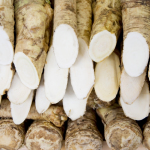 This ancient herb is featured as one of the five bitter herbs of the Jewish Passover festival which starts today. It is a native of Eastern Europe but now grows on other part of Europe as well as the United States. Though it has spiky green leaves that can be used in salads, horseradish is grown mainly for its large, white, pungently spicy roots. It’s roots belong to the mustard family. It has virtually no aroma until you scratch its skin; then, it will emit a sharp, penetrating aroma, similar to mustard oil, causing the eyes to water. It’s a main staple in the Japanese wasabi. Choose roots that are firm with no sign of blemishes or withering. It should be refrigerated, wrapped in a plastic bag and peeled before using. It is most often grated and used in sauces or as a condiment with fish or meat. Add it to sour cream and/or yogurt and you have the creamed horseradish sauce that is a compliment to prime rib.
This ancient herb is featured as one of the five bitter herbs of the Jewish Passover festival which starts today. It is a native of Eastern Europe but now grows on other part of Europe as well as the United States. Though it has spiky green leaves that can be used in salads, horseradish is grown mainly for its large, white, pungently spicy roots. It’s roots belong to the mustard family. It has virtually no aroma until you scratch its skin; then, it will emit a sharp, penetrating aroma, similar to mustard oil, causing the eyes to water. It’s a main staple in the Japanese wasabi. Choose roots that are firm with no sign of blemishes or withering. It should be refrigerated, wrapped in a plastic bag and peeled before using. It is most often grated and used in sauces or as a condiment with fish or meat. Add it to sour cream and/or yogurt and you have the creamed horseradish sauce that is a compliment to prime rib.
This old fashi oned dessert form the motherland of England is made of cooked pureed fruit that is strained, chilled and folded into whipped cream. The fruit mixture may or may not be sweetened. I guess depending on the fruit you use. It is traditional made from gooseberries but any fruit may be substituted. It may assist other fruits that are not popular due to their sour or acidic taste like the rhubarb fruit as pictured. The exact reason why the word “fool” is used is known but heck, makes a perfect posting for April Fool’s day!
oned dessert form the motherland of England is made of cooked pureed fruit that is strained, chilled and folded into whipped cream. The fruit mixture may or may not be sweetened. I guess depending on the fruit you use. It is traditional made from gooseberries but any fruit may be substituted. It may assist other fruits that are not popular due to their sour or acidic taste like the rhubarb fruit as pictured. The exact reason why the word “fool” is used is known but heck, makes a perfect posting for April Fool’s day!
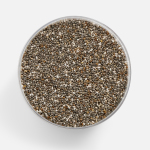 Like flax seeds, chia seed is a rich source of omega-3 fatty acids as well as the omega-6 fatty acid LA, protein and fiber. It also contains several essential nutrients, including calcium, phosphorus, copper, niacin and zine. Because of this, chia seeds, are fast becoming a favorite health food. It’s a member of the mint family and was a significant component of the Aztec and Mayan diets. The seed has a nutlike flavor and is often used simply sprinkled over cereal, yogurt or salads or eaten by itself as a snack. It can also be ground and mixed with flour and used in baked goods. What was once popular in Mexica and Central America is the chia fresca, made by mixing a couple of teaspoon of chia seeds for 8 to 10 ounces of water or fruit juice. Chia seed is naturally gel-like so the mixture will become thickened after a bit of time in your glass. Chia seed, unlike flax seed, does not have a high fat content and can be stored for longer periods without going rancid. Due to the popularity of this seed, you can now find in mostly all the grocery stores and definitely in health food stores like Trader Joes.
Like flax seeds, chia seed is a rich source of omega-3 fatty acids as well as the omega-6 fatty acid LA, protein and fiber. It also contains several essential nutrients, including calcium, phosphorus, copper, niacin and zine. Because of this, chia seeds, are fast becoming a favorite health food. It’s a member of the mint family and was a significant component of the Aztec and Mayan diets. The seed has a nutlike flavor and is often used simply sprinkled over cereal, yogurt or salads or eaten by itself as a snack. It can also be ground and mixed with flour and used in baked goods. What was once popular in Mexica and Central America is the chia fresca, made by mixing a couple of teaspoon of chia seeds for 8 to 10 ounces of water or fruit juice. Chia seed is naturally gel-like so the mixture will become thickened after a bit of time in your glass. Chia seed, unlike flax seed, does not have a high fat content and can be stored for longer periods without going rancid. Due to the popularity of this seed, you can now find in mostly all the grocery stores and definitely in health food stores like Trader Joes.
This 6000  year old snack is from a special variety of dried corn that pops open and puffs up when heated due to the high amount of natural moisture trapped inside the hull. When heated the corn creates immense pressure and bursts open the hull turning the kernel inside out. Did you know Popcorn is a whole grain, which means it’s a good source of dietary fiber? In fact, 1 cup has 1.3 grams of fiber. Andi its gluten free!! Finely ground, it can be used in place of breadcrumbs for a great crunchy coating on chicken and fish. Popcorn is a weight watchers perfect snack – it’s sugar free, fat free, low in calories as it just has 31 calories for 1 cup of air popped popcorn. Packed with protein, ounce for ounce it has more protein than potato chips. It’s also a great snack to keep the hunger pangs away and it’s cheap – just about 19 cents an ounce makes it one of the least expensive snack foods on the market today.
year old snack is from a special variety of dried corn that pops open and puffs up when heated due to the high amount of natural moisture trapped inside the hull. When heated the corn creates immense pressure and bursts open the hull turning the kernel inside out. Did you know Popcorn is a whole grain, which means it’s a good source of dietary fiber? In fact, 1 cup has 1.3 grams of fiber. Andi its gluten free!! Finely ground, it can be used in place of breadcrumbs for a great crunchy coating on chicken and fish. Popcorn is a weight watchers perfect snack – it’s sugar free, fat free, low in calories as it just has 31 calories for 1 cup of air popped popcorn. Packed with protein, ounce for ounce it has more protein than potato chips. It’s also a great snack to keep the hunger pangs away and it’s cheap – just about 19 cents an ounce makes it one of the least expensive snack foods on the market today.
You’ll find t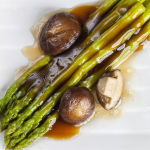 his wonderful condiment in the Asian Section of your grocery store. It’s a dark brown sauce consisting of oysters, brine and soy sauce cooked until thick and concentrated. It is used in many Asian dishes especially stir fry dishes and is also used as a table condiment for many that enjoy this sauce. Oyster sauce gives a richness to dishes without overpowering their original flavor. Try it on your vegetables, especially mushrooms and asparagus as pictured. You can also use it as a dipping sauce if you add a little of hoisin sauce to it for your potstickers or eggrolls.
his wonderful condiment in the Asian Section of your grocery store. It’s a dark brown sauce consisting of oysters, brine and soy sauce cooked until thick and concentrated. It is used in many Asian dishes especially stir fry dishes and is also used as a table condiment for many that enjoy this sauce. Oyster sauce gives a richness to dishes without overpowering their original flavor. Try it on your vegetables, especially mushrooms and asparagus as pictured. You can also use it as a dipping sauce if you add a little of hoisin sauce to it for your potstickers or eggrolls.
Whe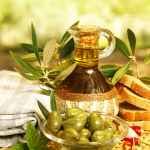 n you press tree-ripened olives they extract a flavorful, monounsaturated oil that is prized throughout the world for both cooking, especially in the Mediterranean countries, and for salads. Today you can find a wide selection of the domestic oil, most comes from the California region but so many are available from the countries of France, Greece, Italy and Spain. And each have their own unique flavor, color and fragrance of olives that dramatically depend on their growing regions and the crops condition. The most common, the Extra Virgin Olive oil is the cold pressed result of the first pressing of the olives and is only 1 percent acid. It’s considered the finest and fruitiest of the olive oils and therefore the most expensive. Try them out with your salads and for cooking – especially when you’re making a Spanish meal, use the Spanish olive oil, Italian? Italian Olive Oil. Heck, host an olive oil tasting next time with a little pieces of French bread and use white little bowls for the different oils and you can see, smell and taste the difference between the olive oils varying from country and their pressings.
n you press tree-ripened olives they extract a flavorful, monounsaturated oil that is prized throughout the world for both cooking, especially in the Mediterranean countries, and for salads. Today you can find a wide selection of the domestic oil, most comes from the California region but so many are available from the countries of France, Greece, Italy and Spain. And each have their own unique flavor, color and fragrance of olives that dramatically depend on their growing regions and the crops condition. The most common, the Extra Virgin Olive oil is the cold pressed result of the first pressing of the olives and is only 1 percent acid. It’s considered the finest and fruitiest of the olive oils and therefore the most expensive. Try them out with your salads and for cooking – especially when you’re making a Spanish meal, use the Spanish olive oil, Italian? Italian Olive Oil. Heck, host an olive oil tasting next time with a little pieces of French bread and use white little bowls for the different oils and you can see, smell and taste the difference between the olive oils varying from country and their pressings.
This cut of b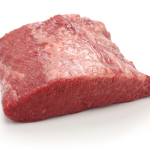 eef is taken from the breast section under the first five ribs of the cow. It is usually sold without the bone and is divided into two sections. The flat cut has minimal fat and is usually more expensive than the more flavorful point cut, has more fat – because we all know that “Fat is Flavor!” Brisket is the cut used for Corned Beef (wait until you see Monday’s post!) This normally tough cut of meat, due to the collagen fibers that make up the significant connective tissue in the cut, is tenderized when the collagen becomes gelatinous, resulting in a more tender brisket. The fat cap, which is often left attached to the brisket, helps to keep the meat from drying during the prolonged cooking that is necessary to break down the connective tissue in the meat. Water is necessary for the conversion of collagen to gelatin, resulting in a tender cut of meat. It is also used at Passover for a delicious pot roast to serve at the Seder Dinner.
eef is taken from the breast section under the first five ribs of the cow. It is usually sold without the bone and is divided into two sections. The flat cut has minimal fat and is usually more expensive than the more flavorful point cut, has more fat – because we all know that “Fat is Flavor!” Brisket is the cut used for Corned Beef (wait until you see Monday’s post!) This normally tough cut of meat, due to the collagen fibers that make up the significant connective tissue in the cut, is tenderized when the collagen becomes gelatinous, resulting in a more tender brisket. The fat cap, which is often left attached to the brisket, helps to keep the meat from drying during the prolonged cooking that is necessary to break down the connective tissue in the meat. Water is necessary for the conversion of collagen to gelatin, resulting in a tender cut of meat. It is also used at Passover for a delicious pot roast to serve at the Seder Dinner.
Corned be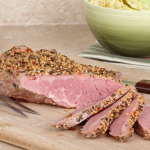 ef is a salt-cured beef product. The term comes from the treatment of the meat with large grained rock salt, also called “corns” of salt. It features as an ingredient in many cuisines, including British, Irish-American, Jewish, Caribbean, Philippine cuisine and Chamorro cuisine (Mariana Islands such as Saipan and Guam)
ef is a salt-cured beef product. The term comes from the treatment of the meat with large grained rock salt, also called “corns” of salt. It features as an ingredient in many cuisines, including British, Irish-American, Jewish, Caribbean, Philippine cuisine and Chamorro cuisine (Mariana Islands such as Saipan and Guam)
It was popular during both World Wars, when fresh meat was rationed. Corned beef remains popular in the United Kingdom and countries with British culinary traditions and is commonly used in sandwiches, corned beefhash or eaten with chips and pickles. It also remains especially popular in Canada in a variety of dishes, perhaps most prominently Montreal smoked meat.
Although the exact beginnings of corned beef are unknown, it most likely came about when people began preserving meat through salt-curing. Evidence of its legacy is apparent in numerous cultures, including Ancient Europe and the Middle East. The word corn derives from Old English, and is used to describe any small hard particles or grains. In the case of “corned beef”, the word may refer to the coarse granular salts used to cure the beef. The word corned may also refer to the corns of potassium nitrate, also known as saltpetre (and one of the main ingredients in gunpowder), which were formerly used to preserve the meat.
In North America corned beef dishes are associated with traditional Irish cuisine. However there is considerable debate about the association of corned beef with Ireland. Mark Kurlansky, in his book Salt, states that the Irish produced a salted beef around the Middle Ages that was the “forerunner of what today is known as Irish corned beef” and in the 17th century the English named the Irish salted beef “corned beef”. Some say it was not until the wave of 18th century Irish immigration to the United States that much of the ethnic Irish first began to consume corned beef dishes as seen today. The popularity of corned beef compared to bacon among the immigrant Irish may have been due to corned beef being considered a luxury product in their native land, while it was cheaply and readily available in America.
In Ireland today, the serving of corned beef is geared toward tourist consumption and most Irish in Ireland do not identify the ingredient as native cuisine.
The Jewish population produced similar koshered cured beef product made from the brisket which the Irish immigrants purchased as corned beef from Jewish butchers. This may have been facilitated by the close cultural interactions and collaboration of these two diverse cultures in the USA’s main 19th and 20th century immigrant port of entry, New York City.
Source: Wikipedia
This is the Chefelle Method of making a tender Corned Beef: Buy either the Flat Cut (minimal fat) or the Point (tip) Cut which has more flavor.
Place your corned beef in a pot, add the seasoning packet if provided and add water, submerging the brisket about halfway through. Bring to a boil and continue boiling for about 3-4 hours, adding water as needed. You can choose to place a lid on the pot or not, but just make sure that water doesn’t evaporate too much. The trick is that this is such a tough piece of meat that this high rolling boil for 3-4 hours finally releases the elasticity of the meat and then it’s as soft and tender as can be. Add the quartered cabbage the last 15 minutes of cooking. And remember to sliced your corned beef AGAINST the grain
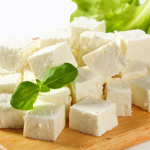 This is a fantastic cheese and one of my personal faves….
This is a fantastic cheese and one of my personal faves….
It’s one of the world’s oldest cheeses and has been made in Greece and other Balkan countries for centuries. Today is made around the world by numerous producers in the countries of Denmark, France, Germany and of course, here in the United States. To truly be called Feta – it must be produced by traditional methods designated in Greece and made from sheep’s milk although 30% of goat’s milk may be added. Large commercial producers often use cow’s milk. There are many varieties to try from semi-soft and smooth to semi-hard and crumbly all depending on what you are using it for. It’s great to toss into hot pasta dishes, use in dips, top your next pizza or use in a sandwich spread too. The semi-hard version is cured and packed in a brine which helps preserve it and make’s it more like a “pickled” cheese. One of my personal favorite brands is Valbreso Feta from France – it comes in brick form but is delicious and very creamy. If you prefer salty foods vs. sweet foods – you’ll love Feta Cheese. And remember, it’s all betta with Feta!!!
Paprika is one of the most widely used spices around the world. A dried powder made from bell peppers or chili peppers, it is commonly used in Hungarian, African, and Spanish cuisines for its color and flavor and has made its way west as a staple, everyday ingredient. So, what’s the difference between regular, Hungarian, sweet, hot, Spanish, and smoked paprika? Here’s the answer:
- “Regular” paprika is the most commonly found and is a blend of sweet and hot varieties and has a relatively neutral flavor. It’s great for adding color to your dishes or as a garnish.
- Sweet paprika (commonly labeled as Hungarian sweet paprika) has a rich, fruity flavor like a red bell pepper with no heat. It’s great as an all-around paprika and more interesting than the regular stuff.
- Hot paprika is made from dried chili peppers and will be more similar to cayenne, but less spicy.
- Spanish smoked paprika (sometimes labeled as Pimenton de la Vera) is made from dried chilis that are smoked over oak giving the spice a woodsy, smokey flavor that is great for stews and roast meats. It can be sweet or hot.
The most important thing when choosing paprika is to think about how you’re going to use it in a recipe and the flavor you want to create. Just need a punch of color? Use regular or sweet. Want a little spice? Grab the hot stuff. Going for an earthy flavor? Try smoked paprika. If you have several on hand, blend them together to achieve just the right mix.
Thanks to Noshonit!
Add a simple refreshing topping to pasta, vegetables and some meat dishes is a gremolata. It consists of fresh finely chopped Italian parsley, lemon zest, olive oil and finely chopped garlic. Try it next time to add color and a fresh flavor to a dish to pump it up!
Potstickers (aka Dumplings, Gyozas) are now a fabulous appetizer or even a main dish if you pair with a crispy green salad full of veggies, you have a well- rounded meal – or in this case “half-moon” meal since this is the shape of these little darlings that I am particularly fond of.
Here’s the thing – when steaming the frozen potstickers that are readily available in any freezer section – yes, I know, I should be making my own, and I have. But in a pinch with last minute drop- in guests, or a quick meal to get on the table they sure come in handy – especially with the options of chicken, pork or vegetable. When steaming in a pasta pot or bamboo steamer (not all of us have one of these either), you don’t want your stickers to stick to the bottom of the pan (though it is ironic they are called “potstickers”) anyway, line your pan with either cabbage or lettuce leaves that will steam beautifully and may add an additional flavor of freshness to your little dumpling darlings! Choose to saute them after or not. Enjoy with your favorite dipping sauce! Chow down!
We love to bring you Tips, Nuggets, Tidbits & Humor (maybe). If you would like us to help make your life easier please submit your questions by clicking here.





